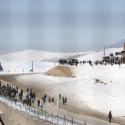Iraq and Syria. The Turkish raid on an alleged ISIS safe house in northwestern Syria on April 28 likely killed an ISIS leader, but not the “caliph.” The US Defense Department said it “could not corroborate” Turkey’s claims that the raid killed the “caliph.” The continued targeting of ISIS leadership is helpful, but it fails to address the group’s ability to embed itself within local populations. ISIS could leverage opportunities in US-backed Syrian Democratic Forces (SDF)-controlled areas to cultivate relationships with local tribes opposed to SDF governance. The SDF approach to governance is counterproductive and causes resentment among local tribes.
Sudan. The al Qaeda and Islamic State networks in Africa will likely seek to use the Sudan conflict to improve their position on the continent. Numerous inmates escaped from a prison in Khartoum city beginning on April 22 amid clashes between Sudan’s two warring factions. Al Qaeda and the Islamic State have previously used conflicts elsewhere in Africa to improve their position on the continent.
Pakistan. Tehrik-e-Taliban Pakistan (TTP) militants based in Afghanistan continue to direct TTP activities in Pakistani cities far outside of TTP’s recent attack zones. Police arrested two TTP militants for extortion in Karachi on April 26. Police said that TTP leadership in Afghanistan directed the militants to extort Pashtun traders. Pakistan will be unable to counter the TTP as TTP leadership continues to provide support from Afghanistan. Pakistan will also be unable to weaken the TTP in Pakistan as the TTP grows its attack capabilities and Islamabad cuts its military expenses.
Afghanistan. A former Taliban official close to Taliban Minister of Interior and Haqqani Network leader Sirajuddin Haqqani called on Taliban supporters in Europe and America to kill critics of the Taliban government. This official claimed the Taliban already had volunteers in Europe and America who could be organized to carry out assassinations of Taliban critics. A stated intent to establish networks to facilitate Taliban-ordered assassinations abroad presents a direct threat to critics of the Taliban—including US and European citizens.










